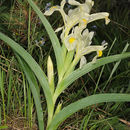en
names in breadcrumbs


Iris caucasica (also known as Caucasian iris)[2][3] is a species of plant in the genus Iris, it is also in the subgenus of Scorpiris. Pronounced as 'kaw-KAS-ee-kuh'.[4]
It was described in 'Commentat. Soc. Phys.' to Caesareae Universitatis Mosquensis of 1808 by Georg Hoffman.[5]
It was once confused with iris orchioides, but iris caucasica is a smaller plant, with sessile flowers. Also it has leaves that have white margins.[6]
Iris caucasica is an accepted name by the RHS.[2]
It has a brown ovoid bulb with fleshy roots.[6] It is similar in form to Iris persica.[3]
It has grey green leaves,[7] which are ciliate[8] and that start growing at flowering time.[9] They reach up to 10–12 cm long and l-2 cm wide.[8] The leaves have a faint white margin.[10]
It has between 1–4 flowers per stem, normally pale yellow or green and with winged falls.[9] The falls also have a yellow ridge.[7] The flowers are 5–15 cm (2–6 in) across.[9] It flowers in late spring.[8] It eventually reaches a height of 15 cm (flower and stem).[8] The flowers are not fragrant.[6]
Iris caucasica grows on limestone mountain slopes (at 1200-3500m above sea level)[8] in Turkey[7] and Armenia and Azerbaijan,[11] in the Caucasus mountains.[7] Bieberstein notes seeing it near Tbilisi in the South Caucasus.[3] It has also been found in Israel and Iran.[10]
In 1892, Michael Foster introduced a hybrid version Iris Caucasica 'Kharput'.[4] Which does not have winged falls.[9] It still has 4–5 flowers per stem, which are greenish-yellow. But they are generally larger than parent plant.[6]
Iris caucasica (or Sarı nevroz, a local name of Ovacık, Dersim) has been used a folk medicinal plant in Turkey. The flowers have been used in an infusion to treat colds.[12]
Iris caucasica (also known as Caucasian iris) is a species of plant in the genus Iris, it is also in the subgenus of Scorpiris. Pronounced as 'kaw-KAS-ee-kuh'.
It was described in 'Commentat. Soc. Phys.' to Caesareae Universitatis Mosquensis of 1808 by Georg Hoffman.
It was once confused with iris orchioides, but iris caucasica is a smaller plant, with sessile flowers. Also it has leaves that have white margins.
Iris caucasica is an accepted name by the RHS.